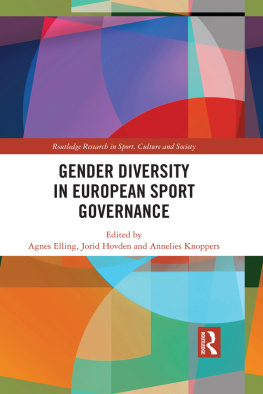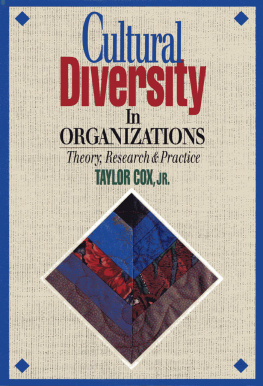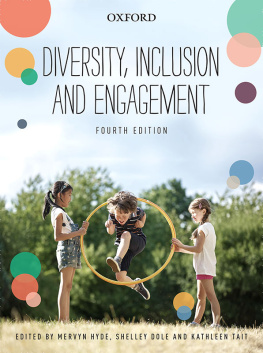It offers strategies for managing diversity in work and sport environments and provides an overview of diversity training that can be implemented in the workplace. Grounded in research and theory and outlining the best practice, this fully updated and revised edition includes more international examples and expanded coverage of topics, such as critical disability studies, women of color, and lesbian, gay, bisexual, transgender, queer, intersex issues, as well as useful teaching and learning features in every chapter and additional online resources.
This is an important reading for students working in the fields of sport business, sport management, sport development or sport coaching, HR management in sport, sport in society, sport participation, ethical leadership in sport, or introductory sport management courses.
ORGANIZATIONS
A MULTILEVEL PERSPECTIVE
FOURTH EDITION
George B. Cunningham

Fourth edition published 2019
by Routledge
52 Vanderbilt Avenue, New York, NY 10017
and by Routledge
2 Park Square, Milton Park, Abingdon, Oxon, OX14 4RN
Routledge is an imprint of the Taylor & Francis Group, an informa business
2019 George B. Cunningham
The right of George B. Cunningham to be identified as author of this work has been asserted by him in accordance with sections 77 and 78 of the Copyright, Designs and Patents Act 1988.
All rights reserved. No part of this book may be reprinted or reproduced or utilised in any form or by any electronic, mechanical, or other means, now known or hereafter invented, including photocopying and recording, or in any information storage or retrieval system, without permission in writing from the publishers.
Trademark notice: Product or corporate names may be trademarks or registered trademarks, and are used only for identification and explanation without intent to infringe.
First edition published by Holcomb Hathaway 2007
Third edition published by Routledge 2015
British Library Cataloguing-in-Publication Data
A catalogue record for this book is available from the British Library
Library of Congress Cataloging-in-Publication Data
Names: Cunningham, George B., author.
Title: Diversity and inclusion in sport organizations: a multilevel
perspective / George B. Cunningham.
Description: Fourth edition. | Abingdon, Oxon; New York, NY: Routledge, 2019. | Includes bibliographical references and index.
Identifiers: LCCN 2018046790 | ISBN 9781138586949 (hbk) |
ISBN 9781138586956 (pbk) | ISBN 9780429504310 (ebk)
Subjects: LCSH: Sports administrationUnited States. | Discrimination in
sportsUnited States. | Diversity in the workplaceUnited States.
Classification: LCC GV713 .C86 2019 | DDC 796.06/9dc23
LC record available at https://lccn.loc.gov/2018046790
ISBN: 978-1-138-58694-9 (hbk)
ISBN: 978-1-138-58695-6 (pbk)
ISBN: 978-0-429-50431-0 (ebk)
Typeset in Sabon
by codeMantra
Visit the eResources: www.routledge.com/9781138586956
For Melissa, Harper, and Maggie
Contents
A Diversity and inclusion are, and will continue to be, among the most important issues managers encounter, particularly in the sport industry. Countries around the world are growing more diverse, in terms of both demographics and attitudes, and todays sport organizations reflect this diversity. Organizational strategies to promote, create, and sustain inclusiveness can influence employees attitudes, group processes, and the organizations overall effectiveness. Following diversity-related legal requirements, or failing to do so, can also have meaningful implications for an organization. Consequently, it is of paramount importance that managers understand the effects of diversity and inclusion and the strategies to manage differences effectively. The purpose of the fourth edition of Diversity and Inclusion in Sport Organizations: A Multilevel Perspective is to provide students with such an understanding.
As the books new title suggests, in the fourth edition, I draw from multilevel theory to overview diversity and inclusion in sport. Doing so allows for a compre-hensive treatment of the topic.
I have divided the book into three parts. addresses stereotypes, prejudice, and discrimination; the theoretical tenets undergirding those constructs; and their associated outcomes.
).
). In this chapter, I offer an overview of sport for development and peace programs, potential outcomes, and guiding principles for those who are using sport to promote social change.
The book is intended for upper-level undergraduate and graduate students. Teachers, coaches, managers, marketers, and administrators also will benefit from the texts information. Because the sport industry is composed of many segments, examples are drawn from a bevy of sourcesprofessional sports, university athletics, fitness organizations, physical education, recreation and leisure settings, and nonprofit entities.
THE BOOKS SPECIAL FEATURES
 Diversity Challenge. Each chapter opens with a diversity challenge, a real-life scenario introducing the chapters topic. It is followed by a series of questions to prompt readers to think about the issues raised.
Diversity Challenge. Each chapter opens with a diversity challenge, a real-life scenario introducing the chapters topic. It is followed by a series of questions to prompt readers to think about the issues raised.
 Diversity in the Field. These sidebars present real-life examples to help readers comprehend chapter concepts.
Diversity in the Field. These sidebars present real-life examples to help readers comprehend chapter concepts.
 Professional Perspectives. These recurring boxes reflect interviews of leading professionals with responsibilities in sport (e.g., a sport industry employment recruiter, professors, an athletic director, a high school coach) and provide students with practical, informed opinions on the chapter content.
Professional Perspectives. These recurring boxes reflect interviews of leading professionals with responsibilities in sport (e.g., a sport industry employment recruiter, professors, an athletic director, a high school coach) and provide students with practical, informed opinions on the chapter content.
 Alternative Perspectives. Because many topics and issues stimulate a wide range of opinions, I have included Alternative Perspectives boxes to provide readers with additional sides of a discussion.
Alternative Perspectives. Because many topics and issues stimulate a wide range of opinions, I have included Alternative Perspectives boxes to provide readers with additional sides of a discussion.
 Questions for Discussion, Learning Activities, Reading Resources, and Web Resources. Each chapter concludes with discussion questions, student activities, and sources of additional information. Many of the Learning Activities are designed for students to explore in small groups. The annotated Web Resources augment chapter material by providing links to online resources such as professional associations, electronic methods of testing prejudicial attitudes, resources for diversity training, and others. Finally, the annotated Reading Resources recommend additional informative books related to the chapters discussions.
Questions for Discussion, Learning Activities, Reading Resources, and Web Resources. Each chapter concludes with discussion questions, student activities, and sources of additional information. Many of the Learning Activities are designed for students to explore in small groups. The annotated Web Resources augment chapter material by providing links to online resources such as professional associations, electronic methods of testing prejudicial attitudes, resources for diversity training, and others. Finally, the annotated Reading Resources recommend additional informative books related to the chapters discussions.









 Diversity Challenge. Each chapter opens with a diversity challenge, a real-life scenario introducing the chapters topic. It is followed by a series of questions to prompt readers to think about the issues raised.
Diversity Challenge. Each chapter opens with a diversity challenge, a real-life scenario introducing the chapters topic. It is followed by a series of questions to prompt readers to think about the issues raised.